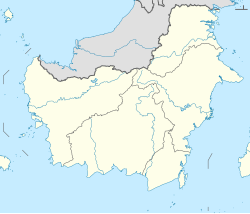Sampit | |
|---|---|
Clockwise from top: Sampit seen from above, Sampit Peace Monument, Jelawat Fish Statue, & Mentaya Shopping Center | |
| Coordinates: 2°32′S112°57′E / 2.533°S 112.950°E | |
| Country | Indonesia |
| Province | Central Kalimantan |
| Regency | East Kotawaringin Regency |
| Area | |
• Total | 651.32 km2 (251.48 sq mi) |
| Population | |
• Estimate (mid 2024 estimate) | 171,624 |
| • Density | 263.5/km2 (682/sq mi) |
| Time zone | UTC+7 (Western Indonesian Time) |
Sampit is a large town located in East Kotawaringin Regency, Central Kalimantan. Previously a timber port town, it has grown to be a medium-sized community with a population of 166,773 according to Statistics Indonesia in 2019, with the economy having since divested from timber products. However, the town is not an autonomous city and not an administrative division by despite having a sizeable population and urban built-up. It consists of eleven urban villages (kelurahan) and two "rural" villages (desa), comprising Mentawa Baru Ketapang District (all except 5 desa in the south of the district), Baamang District (fully) and part of Seranau District (only one kelurahan), as detailed below. The total area of the town is 651.32 square kilometres and the population was estimated at 171,624 as at mid 2024. [1]
Contents
- Etymology
- History
- Early history
- Modern history
- Climate
- Infrastructure
- Transportation
- Health and education
- Others
- References
| Kode Wilayah | Name of District (kecamatan) | Name of kelurahan or desa | Area in km2 | Pop'n Estimate mid 2024 | Post codes |
|---|---|---|---|---|---|
| 62.02.06.1003 | Mentawa Baru Ketapang | Ketapang | 19.52 | 28,554 | 74325 |
| 62.02.06.2010 | Mentawa Baru Ketapang | Telaga Baru (desa) | 11.67 | 5,006 | 74326 |
| 62.02.06.1002 | Mentawa Baru Ketapang | Mentawa Baru Hilir | 8.81 | 23,531 | 74323 |
| 62.02.06.1001 | Mentawa Baru Ketapang | Mentawa Baru Hulu | 7.46 | 16,199 | 74322 |
| 62.02.06.1007 | Mentawa Baru Ketapang | Sawahan | 5.51 | 9,465 | 74321 |
| 62.02.06.1009 | Mentawa Baru Ketapang | Pasir Putih | 138.17 | 9,196 | 74322 |
| 62.02.12.1001 | Seranau | Mentaya Seberang | 253.33 | 3,774 | 74324 |
| 62.02.05.1001 | Baamang | Baamang Hilir | 0.81 | 8,584 | 74311 |
| 62.02.05.1002 | Baamang | Baamang Tengah | 5.54 | 31,170 | 74312 |
| 62.02.05.1003 | Baamang | Baamang Hulu | 87.85 | 13,880 | 74313 |
| 62.02.05.1007 | Baamang | Tanah Mas | 17.11 | 1,619 | 74312 |
| 62.02.05.1008 | Baamang | Baamang Barat | 42.19 | 19,031 | 74312 |
| 62.02.05.2006 | Baamang | Tinduk (desa) | 53.35 | 1,615 | 74316 |
| Total | 651.32 | 171,624 |





